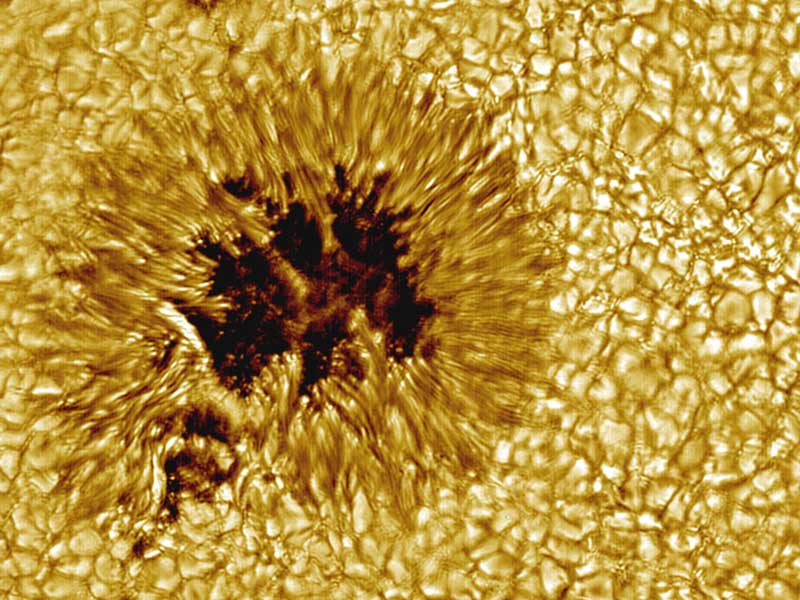Skip to comments.
Astronomy Picture of the Day (November 6, 2005)
APOD ^
| November 6, 2005
| APOD
Posted on 11/06/2005 2:01:42 AM PST by zeugma
Astronomy Picture of the Day
Discover the cosmos! Each day a different image or photograph of our fascinating universe is featured, along with a brief explanation written by a professional astronomer.
2005 November 6

A Sunspot Up Close
Credit : Vacuum Tower Telescope, NSO, NOAO
Explanation: Why would a small part of the Sun appear slightly dark?
Visible above is a close-up picture of a
sunspot, a depression on the Sun's face that is slightly cooler and less luminous than the rest of the Sun.
The Sun's complex magnetic field creates this cool region by inhibiting hot material from entering the spot.
Sunspots can be larger than the Earth and typically last for only a few days.
This high-resolution picture also shows clearly that the Sun's face is a bubbling sea of separate cells of
hot gas.
These cells are known as granules.
A solar granule is about 1000 kilometers across and lasts about 10 minutes. After that, many granules end up exploding.
Tomorrow's picture: bubble vs. cloud
TOPICS: Miscellaneous
KEYWORDS: apod; astronomy; sunspot
Today's APOD is a Cool One, relatively speaking. Click the image for a bigger version of the pic.
1
posted on
11/06/2005 2:01:43 AM PST
by
zeugma
To: zeugma
2
posted on
11/06/2005 2:16:47 AM PST
by
D-fendr
To: D-fendr
Glad to be of service. APOD is a great place! My current desktop backgrounds comes from a rotating series of previous APOD images. Some are absolutely astounding. If you search the archive section of APOD for the Hubble Deep Field, you won't be disappointed.
3
posted on
11/06/2005 2:20:00 AM PST
by
zeugma
(Warning: Self-referential object does not reference itself.)
To: zeugma
Last night the Mrs. brought me out to the lanai and asked what planet that was next to the crescent moon. I couldn't give her an answer. So my question is, What is the planet that was at "3:00" to the moon last night and probably for the last week or so??
TIA.
ThreePuttinDude
4
posted on
11/06/2005 2:26:17 AM PST
by
ThreePuttinDude
(Liberal Hopes Daschled Again)
To: zeugma
All fires eventually burn out. I wonder how long the sun will burn before we are left in the freezing cold dark.
5
posted on
11/06/2005 3:04:27 AM PST
by
GloriaJane
(http://music.download.com/gloriajane "Seems Like Our Press Has Turned Against Our Country")
To: ThreePuttinDude
6
posted on
11/06/2005 3:07:26 AM PST
by
geege
To: ThreePuttinDude
Check out www.spaceweather.com.....it'll explain why Venus is so close to the moon.
7
posted on
11/06/2005 3:14:41 AM PST
by
geege
To: geege
Thanks for the site. It looks as if it is Venus.
Great website. I've book marked it.
Thanks again.....TPD
8
posted on
11/06/2005 3:20:25 AM PST
by
ThreePuttinDude
(Liberal Hopes Daschled Again)
To: GloriaJane
"
All fires eventually burn out. I wonder how long the sun will burn before we are left in the freezing cold dark."
In about 5 billion years or so, the sun will expand into a red giant and engulf the Earth, which will be vaporized. Then, having expended all of it's fuel, it will subside into a white dwarf and shine by residual heat only, slowly cooling into a dead cinder over 20 billion years or so.
To: zeugma
10
posted on
11/06/2005 5:31:23 AM PST
by
silverleaf
(Fasten your seat belts- it's going to be a BUMPY ride.)
To: zeugma
Great post. My homepage has been set to Refdesk.com for years and I try to check APOD every day. The Hubble Deep Field is the most impressive image I have ever seen ... then when you read just how much of a SMALL area of the cosmos was photographed ... it's impossible to wrap your head around it.
11
posted on
11/06/2005 5:52:56 AM PST
by
manwiththehands
(Big Lie #1: "Islam is a peaceful religion"; Big Lie #2: Bush "lied")
To: ThreePuttinDude
It was Venus. When it is visible, Venus is the brightest thing in the sky besides the moon. I saw that last night also.
If you looked at the other side of the sky (try again tonight), the bright orange/red object is Mars. It rises when the sun sets right now.
12
posted on
11/06/2005 6:54:19 AM PST
by
Wacka
To: zeugma
No pun intended but it looks like a sunflower to me.
13
posted on
11/06/2005 7:04:33 AM PST
by
xp38
To: zeugma
To: manwiththehands
I love showing the Deep Field to people. Explaining how small a slice of the sky that is, and that every single speck you see on that image is a galaxy... Blows people's minds. I think it is astounding that Hubble can image like that. Remember back when it was launched? The media was squawking like chicken little complaining that it was next to useless. Fortunately, our engineers were able to not only work around the spherical abberation, but were ultimately able to make Hubble see better than designed.
The Deep Field is the ultimate tool to put some perspective into folks.
15
posted on
11/06/2005 8:41:57 AM PST
by
zeugma
(Warning: Self-referential object does not reference itself.)
To: zeugma
They had to focus the Hubble on that single point in the sky for something like 3 weeks straight to get the Deep Field. The resolution and precision of that thing is astounding! It's sad to think we might lose funding to keep it operating before it quits working.
16
posted on
11/06/2005 8:47:42 AM PST
by
manwiththehands
("They wanted a Harley, they got a Scooter Libby." -Don Surber)
Disclaimer:
Opinions posted on Free Republic are those of the individual
posters and do not necessarily represent the opinion of Free Republic or its
management. All materials posted herein are protected by copyright law and the
exemption for fair use of copyrighted works.
FreeRepublic.com is powered by software copyright 2000-2008 John Robinson
